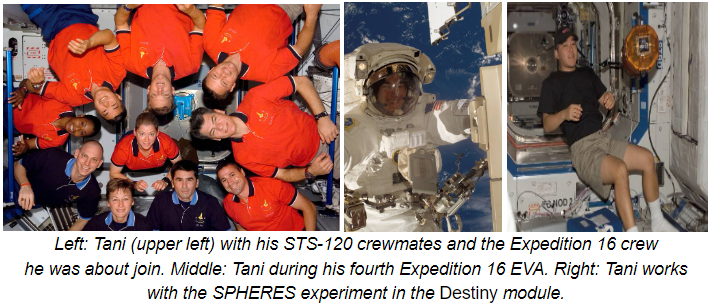In honor of Asian-American Pacific Islander Heritage Month, we recognize astronauts with Asian roots who have flown to the International Space Station (ISS) and contributed to its assembly, operations and research activities. They were preceded in space by other pioneers. The first person in space of Asian origin was Phạm Tuân of Vietnam who spent eight days aboard the Salyut-6 space station in 1980 as part of the Soviet Union’s Interkosmos program to fly cosmonauts from friendly socialist countries. The first American in space of Asian descent was Ellison S. Onizuka when he flew as a Mission Specialist aboard Space Shuttle Discovery’s STS-51C mission in 1985.
In this article, we recognize the American astronauts of Asian and Pacific Island heritage who have flown aboard ISS, contributing to its construction and operation and conducting the world-class research for which the station is known. The table below lists these individuals and others of different nationalities who have similarly shared in this remarkable international adventure. Asian-American astronauts from recent selections await their chance to contribute to the success of ISS and to future exploration missions.
The honor of being the first Asian-American to fly to ISS belongs to astronaut Edward T. “Ed” Lu. Already a veteran of STS-84, the sixth Shuttle docking mission to the Russian space station Mir, Lu served as a Mission Specialist on STS-106. He and his six crewmates launched on Sep. 8, 2000, with the primary goal of preparing ISS for its first occupants. At the time, the station comprised just three modules: the Zarya Functional Cargo Block (FGB), the Unity Node 1 and the Zvezda Service Module, the latest addition to the station having just arrived two months earlier. At ISS, the crew’s duties included unloading a Progress resupply craft of its cargo and transferring logistics from the double Spacehab module in Atlantis’ payload bay. Lu and crewmate Yuri I. Malenchenko conducted a six-hour Extra-Vehicular Activity (EVA) or spacewalk to connect electrical cables between the Zarya and Zvezda modules and to install a boom magnetometer on the outside of Zvezda.
Lu returned to ISS in 2003, this time as Expedition 7 Flight Engineer, with his STS-106 crewmate Malenchenko as his Commander. They launched on April 26 aboard Soyuz TMA2, the first two-person long-duration crew in the wake of the Columbia accident. The station had grown significantly since their last visit, with the addition of the Destiny US laboratory module, the Canadarm2 robotic manipulator, a pair of large solar arrays and two truss segments. In tribute to his home state of Hawaii, Lu enjoyed wearing colorful Aloha shirts and used a pair of Hawaiian musical instruments called pu’ili sticks for an educational demonstration. Aware of his penchant for the colorful Hawaiian shirts, personnel in Mission Control all wore them to remotely celebrate Lu’s 40th birthday in July. Lu and Malenchenko returned to Earth in October after 185 days in space.
By the time Leroy Chiao made his first visit to ISS, he had already flown two Space Shuttle missions. During STS-92, he and his crewmates continued to prepare the station for its first occupants. Launching aboard Discovery on Oct. 11, 2000, they docked with ISS two days later and began their assembly tasks. Chiao participated in two of the mission’s four EVAs with crewmate William S. McArthur to install the Z1 truss segment, the Space-to-Ground Antenna (SGANT), Control Moment Gyros (CMGs) and the third Pressurized Mating Adapter (PMA), spending more than 13 hours outside.
For his second visit to ISS, Chiao went to stay, as Commander of Expedition 10. He and his crewmate, Russian cosmonaut Salizhan S. Sharipov originally from Kyrgyzstan, launched aboard Soyuz TMA-5 on Oct. 14, 2004. The two conducted maintenance on the station and performed a pair of EVAs. Part of Chiao’s research program involved ultrasound studies in microgravity. As a first, he submitted the results of the experiment to a scientific journal from ISS. Chiao and Sharipov landed back on Earth in April 2005 after 193 days in space.
On his first space flight, Mark L. Polansky served as Pilot of STS 98, the mission that delivered the US Laboratory Module Destiny to ISS in February 2001. In addition to accommodating research facilities and life support systems, Destiny significantly increased the station’s habitable volume. Atlantis’ astronauts performed three EVAs to complete the installation of the module, which they jointly dedicated with the Expedition 1 crew of William M. Shepherd, Yuri P. Gidzenko and Sergei K. Krikalev, nearing the end of their history-making mission.
For his second visit to ISS in December 2006, Polansky served as Commander of STS-116, the flight that delivered the P5 truss segment to the station. The first post-Columbia crew rotation took place during STS-116, in which Sunita L. “Suni” Williams replaced European Space Agency (ESA) astronaut Thomas Reiter on the Expedition 14 crew. The STS-116 astronauts conducted four EVAs to install and connect the P5 truss and to reconfigure the station’s electrical power channels, some of the most complex tasks ever accomplished in space.
Polansky once again served as Commander for his third and final visit to ISS, STS-127 in July 2009. During this mission, Space Shuttle Endeavour delivered the Exposed Facility for the Kibo Japanese Experiment Module (JEM-EF), a platform for hosting external payloads. Several members of the crew completed five EVAs to perform a variety of assembly and maintenance tasks. As part of a crew rotation, Timothy L. Kopra replaced Japan Aerospace Exploration Agency (JAXA) astronaut Koichi Wakata on the Expedition 20 crew.
Daniel M. Tani completed his first space flight during Space Shuttle Endeavour’s STS-108 mission. Launched on Dec. 5, 2001, Endeavour carried the Rafaello Multi-Purpose Logistics Module (MPLM) in its payload bay, bringing supplies and scientific equipment to ISS. Tani completed a 4-hour EVA with crewmate Linda M. Godwin to install insulation blankets on the station’s solar array rotary joints. The mission also completed the handover between the Expedition 3 and 4 crews.
Next up for Tani was a long-term visit to ISS, as a member of Expedition 16. He launched as part of the STS-120 crew on Oct. 23, 2007, the flight of Discovery that brought the Harmony Node 2 module to ISS. A critical station element, Node 2 served as a hub for the addition of the European and Japanese research modules. While Discovery was still docked to ISS, Tani conducted one EVA with Scott E. Parazynski to disconnect the P6 truss segment from its Z1 location prior to its robotic relocation to the main station truss. After joining the Expedition 16 crew, having exchanged places with Clayton C. Anderson, Tani performed five stage EVAs with ISS Commander Peggy A. Whitson to finish the installation of the Harmony module. Swapping places with ESA astronaut Léopold P. Eyharts, Tani returned to Earth in February 2008 during the STS-122 mission of Atlantis, the flight that brought the European Columbus research module to ISS. His efforts helped to greatly enlarge the station’s capabilities. During his two flights, Tani spent 132 days in space and 39 hours on spacewalks.
During his record-tying seventh trip into space, Franklin R. Chang-Díaz made his only visit to ISS. The main goals of Endeavour’s STS-111 mission, launching on June 5, 2002, included the exchange of the Expedition 4 and 5 crews and the resupply of ISS using the Leonardo MPLM. Two new research facilities were among the MPLM’s cargo. Chang-Díaz completed three EVAs with crewmate French astronaut Philippe Perrin to install the Mobile Base System (MBS) portion of the Canadarm2’s remote manipulator system and perform maintenance tasks on the station.
As noted above, Suni Williams arrived on ISS with STS-116 in December 2006 during one of the busiest and most complex periods of space station assembly. In addition to the arrival of new truss segments, astronauts reconfigured the station’s power system. While still a Shuttle crewmember, Williams participated in one of the EVAs with crewmate Robert L. Curbeam as part of the power reconfiguration. She joined the Expedition 14 crew, replacing ESA astronaut Reiter, as only the third female ISS long-duration crewmember. With Expedition 14 Commander Michael E. Lopez-Alegria she performed three more EVAs to complete the activation of the station’s ammonia cooling system. In April 2007, during her transition to the Expedition 15 crew, Williams “ran” the Boston Marathon on the station’s treadmill, wearing number 14000 and finishing in 4 hours and 24 minutes. She exchanged places with Clay Anderson during the STS-117 mission that delivered the S3/S4 truss and a new pair of solar arrays to ISS. Williams returned to Earth after 191 days in space, at the time the longest flight by a woman. The more than 29 hours she spent outside on her four spacewalks also set a record for women.
For an encore, Williams returned to ISS in July 2012 when she launched aboard Soyuz TMA-05M with Yuri Malenchenko and JAXA astronaut Akihiko Hoshide. They joined Gennadi I. Padalka, Sergey N. Revin and Joseph M. Acaba who had been aboard ISS since May as Expedition 32. In September, just prior to his crew’s departure Padalka turned command over to Williams, who became just the second female commander of ISS. Five weeks later, Williams, Malenchenko and Hoshide welcomed three new crewmembers to round out Expedition 33, Oleg V. Novistsky, Yevgeni I. Tarelkin and Kevin A. Ford. In addition to a full complement of research activities, Williams and her crewmates oversaw the arrival of four resupply vehicles including two Progress, one HTV (H-II Transfer Vehicle), and the first operational mission of Space Exploration Corporation’s (SpaceX) Dragon commercial cargo craft. Williams and Hoshide performed 4 EVAs for a variety of repair and maintenance tasks, extending her record to more than 50 hours across her career 7 spacewalks. Williams and her two crewmates returned to Earth after 127 days in space.
Kjell N. Lindgren’s first flight into space began on July 22, 2005, with a launch aboard Soyuz TMA-17M with Russian veteran cosmonaut Oleg D. Kononenko and Japanese first-time flyer JAXA astronaut Kimiya Yui. They joined the Expedition 44 crew of Gennadi Padalka, Scott J. Kelly and Mikhail B. Korniyenko, the latter two four months into their planned year-long mission aboard ISS. Lindgren began a busy research program that among other experiments included the growing of lettuce in the Veggie apparatus. As a bonus, the scientists allowed the crewmembers to taste the lettuce, first plain and then with oil and vinegar, prior to freezing the remaining plants for analysis back on Earth. A new crew arrived in September, including Sergey A. Volkov as a new resident crewmember and ESA astronaut Andreas E. Mogensen and Kazakh cosmonaut Aidyn A. Aimbetov making short visits to ISS, the unusual direct handover necessitated by the 1-year mission. Prior to his departure with the two short-term visitors, Padalka handed command of the station to Kelly for Expedition 45. Lindgren and Kelly performed two EVAs, spending 15 hours outside performing upgrades and maintenance on the station. Lindgren, Kononenko and Yui returned to Earth in December after spending 142 days in space.
To be continued…
















































